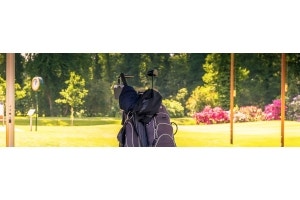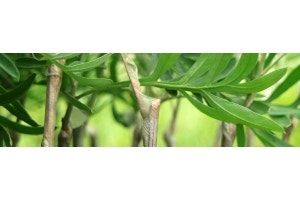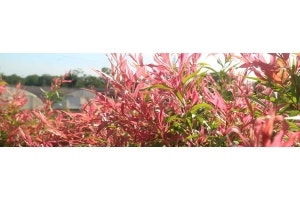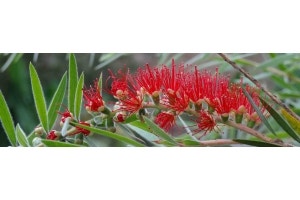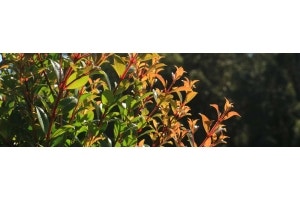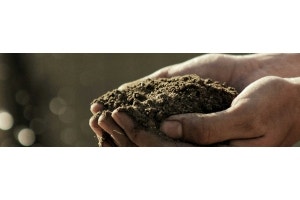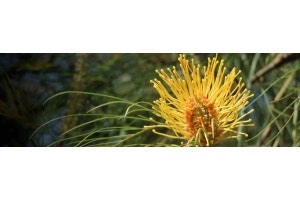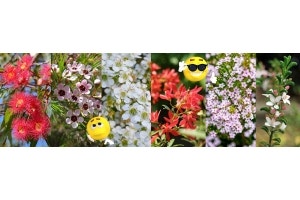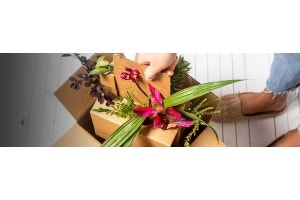
Gardening For Birds
If you want to see more birds in your back garden, then plant the widest range of plants - and you'll soon enjoy the widest range of birds. Plant :- flowering plants for nectar-feeders and honeyeaters
- berry and fruit plants for fruit-eaters
- grasses and seedheads for seed-eaters
- hedges and dense shrubs for shelter
- tall shrubs and trees for perches and roosts
Feed The Birds
There's heaps to choose from when it comes to planting food for birds : nectar-rich flowering plants; bushtucker berries and fruit; seedheads and cones.

Native Nectar Plants
Many birds love to lap up sweet energy-giving nectar, like this wattle bird here using its long tongue to reach into the grevillea flowers.Grevilleas are a favourite for Aussie gardeners to plant, when we want to attract native birds to our home. As gardeners, we want to grow the biggest showiest flowers on our shrubs;
as bird-lovers, we need to make space for smaller, less individually eye-catching, blooms. They may be less showy, but smaller flowers are often easier for birds to feed from - and the smaller flowers are often produced in abundance, so there's plenty of colour for us to enjoy.
Good smaller-flowered grevilleas to plant include:
- warm pink Liliane
- cool pink shrubby silky grevillea
- butter yellow groundcover Sunkissed
- free-flowering scarlet Deua Flame
- prickly dense Pink Pearl
- tropical glossy-leaved Orange Marmalade
Pair grevilleas with other native plants that thrive in similar soil types and climate conditions, such as :
- bell-flowered correa
- tall golden yellow wattle
- brightly-coloured bottlebrush
- bushy honey myrtle
- aromatic lemon darwinia

More Nectar Plants
It's not just grevilleas that make excellent nectar-rich plants for bird-friendly gardens.Underplanting of all kinds creates a range of helpful protective habitats, and helps deter boisterous birds like noisy miners.Our Autumn Colour and Winter Colour categories can help you find flowering plants for all seasons of the year.Good nectar-rich flowering shrubs to plant include the ones these acrobatic little birds are feeding happily on :
- free-flowering salvia - flowering sage
- sun-loving flowering aloe and red hot poker
- sweet-scented rondeletia
These have smaller flowers, or long tubular flowers, that are easy for the slender beaks of spinebills and honeyeaters to drink from. There's plenty of flowers in each cluster or stem, which means fewer trips for a hungry bird to get a feed.
 Good nectar-rich shrubs and trees to plant include :
Good nectar-rich shrubs and trees to plant include :
- big and bold New Zealand Christmas bush
- red-blossomed rainforest tree waratah
- native firewheel tree
- vibrant yellow golden penda
- native favourites bottlebrush
- fluffy-flowered eucalypts
These larger garden plants have more open, often 'fluffy', flowers in abundance, which makes them very attractive garden plants for us to enjoy. They are also enjoyed by nectar-loving birds like lorikeets, wattlebirds, and native parrots.
Like the smaller-flowered plants above, there's plenty of flowers in each cluster or on each branch, which means visiting birds can get their nectar fill-up in one stop.

Berry & Fruit Plants
Some birds love a fruity feed, like colourful fruit doves and speckled koels which feast on native bangalow palms in season. Silvereyes, pigeons, bowerbirds and figbirds will all enjoy a meal of fig berries and blue quandongs.(Cassowaries love quandongs too, but you're less likely to see these in your back yard unless you are gardening in the Top End!)
In a cold snap, native birds are appreciative of many sources of nutrition, including exotic shrubs and fruit trees - cotoneaster berries make a delicious meal for a hungry gang gang.
Wise bird-friendly planting provides a buffet of choices throughout the year, for all sizes of birds : something for everyone to feed on, whatever the weather.
Good native bushtucker plants include :
- plum pine tree
- Burdekin plum tree
- orange-berried tulipwood
- yellow-berried tuckeroo
- white-berried midgem berry
- blue-berried native ginger
- red- and purple-berried lillypilly hedges
Good berry-bearing exotic shrubs include :
- blue-berried Indian hawthorn
- red-berried cotoneaster
- spiny red-berried holly
- pink-flowered acerola, rich in vitamin C
- glossy evergreen dwarf fig
- glossy evergreen carissa
- juicy purple blueberry, if you can bear to share!

Seed & Nut Plants
Many birds appreciate crunchy protein-rich seeds and cones - cockatoos, rosellas and other larger-beaked seed-eating birds can crack open the pods of banksia, gumnuts, she-oak and conifers.Smaller birds like finches and bronzewings, and ground feeders like galahs, prefer to nibble on easier-to-reach seedheads of grasses, and the opened pods of wattle and grevillea.
Good seed and nut-bearing plants include :
- Aussie favourite banksia
- blue-flowered native dianella
- easy-going tussock grass
- big grassy carex sedge
- knobby club rush
- golden annual sunflowers
- purple prairie coneflower
Gimme Shelter
 Food is important but shelter is valuable to birds as well - a safe place to rest, nap, hide from predators or stay out of the weather.
Bird-friendly gardens incorporate a wide range of plants - for birds to eat from, and for birds to live in. Thoughtful gardeners provide layers of plants, to suit all birds - low carpets of groundcover; tufty clumps of grasses; small dense shrubs, wall-hugging climbers; large airy shrubs, and tall trees.
Food is important but shelter is valuable to birds as well - a safe place to rest, nap, hide from predators or stay out of the weather.
Bird-friendly gardens incorporate a wide range of plants - for birds to eat from, and for birds to live in. Thoughtful gardeners provide layers of plants, to suit all birds - low carpets of groundcover; tufty clumps of grasses; small dense shrubs, wall-hugging climbers; large airy shrubs, and tall trees.
Create mixed borders, cottage gardens, underplanting, and intertwining plants that nestle against each other.These create corridors and 'ladders' to help small birds safely move between spaces in a garden, without crossing open flat areas where they are vulnerable to predators.
Interestingly-landscaped gardens with multiple layers of plants will attract a wide assortment of smaller birds.Gardens with open flat lawns and feature trees, but no collections of shrubs or layered underplanting, are more likely to attract flocks of larger boisterous birds like noisy miners and currawongs.
Shelter & Refuge Plants
 Smaller birds appreciate a place of refuge - low bushes and hedges are often favourites, providing a good hiding place. Dense bushes with small leaves are ideal for little birds to hide away in.
Smaller birds appreciate a place of refuge - low bushes and hedges are often favourites, providing a good hiding place. Dense bushes with small leaves are ideal for little birds to hide away in.Shelter bushes are much more than a safe retreat when little birds feel threatened. They also provide a warm place to hide out in storms and windy weather; and a cool shady spot to snooze in the summer.Look for dense bushy shrubs with small leaves, and plenty of layered branches for perching on and building nests between.Prickly and thorny bushes are particularly effective at keeping out predatory mammals, and helping small birds stay safe.
Good native shelter bushes include :
- tall weeping baeckea
- larger tea tree
- smaller paperbarks
Good exotic shelter bushes include :
- weeping waterfall plant
- thorny maroon-red berberis
- white-flowered gold-leaved abelia
- sweet-scented hedging port wine magnolia
- evergreen privet

Sheltering Grasses
It's not just dense shrubs, bushy hedges, and tree hollows that provide valuable shelter for birds in the garden.Grassy plants are a sanctuary, especially for smaller birds. Good native grassy shelter plants include :- tough and rugged mat rush
- blue-flowered dianella
- low-maintenance tussock grass
Safe Houses
Large open trees with layered branches provide perches for larger birds to scope out their surroundings. Prey birds like kookaburras, kingfishers and owls, by contrast, make good use of any exposed branches and handy perches.Here they can scan for their next passing snack, and quickly launch into flight. It's why, if you can, leaving a dead tree is a real help for birdlife. They are an essential part of the ecosystem.As well as perching posts, the trees provide holes for nesting and roosting in; and decaying wood to feed bugs and fungi, that in turn provide food for smaller insect-eating birds.Being less tidy is a fantastic way to help wildlife thrive in your back yard. Easy as!

Let The River Run
If you are lucky enough to have a pond or creek in your back garden, that may attract a wider range of wildlife looking for a drink - like frogs, lizards, and small mammals. These animals also appreciate cool shelter to hide in out of the hot sun and the glare of predators - long grassy plants are particularly welcome in summer heat.Yes, the frogs and lizards that shelter in the grass may end up as food for hungry kookaburras, owls, butcherbirds and raptors -
but that, as Tim and Elton said, is the ciiiiircle of liiiiife...
Good native water-loving grassy shelter plants include : These grassy plants love growing on creek banks, in boggy spots, and on the margins of ponds - ideal habitats for amphibians, and ideal plants for wetter soils.
 Some smaller birds - like the beautiful acrobatic bee-eater - eat the insects that flourish in healthy gardens and alongside bodies of water. If you have space for a small pond or even a water barrel, insects like dragonflies and bees will visit, providing more wildlife viewing opportunities for you, and more snack opportunities for the birds.
Some smaller birds - like the beautiful acrobatic bee-eater - eat the insects that flourish in healthy gardens and alongside bodies of water. If you have space for a small pond or even a water barrel, insects like dragonflies and bees will visit, providing more wildlife viewing opportunities for you, and more snack opportunities for the birds.
You might also see insect-loving robins, fairy wrens, pardalotes and willie wagtails coming for lunch.
Water is essential to almost all life forms - and birds need it year round : to drink from, and to take a bath in too. A cold shower is very refreshing on a hot dusty day! You don't need a fancy bird bath - any shallow broad dish will do. If it's light, weight it with a stone or two inside.Place it in dappled shade, close to low trees or bushes, so that nervous birds can quickly retreat to safety when they need to. Fill it with fresh water, daily if you can, and clean it regularly. We guarantee it's one of the quickest ways to get birds to visit you!
Keep It Wildlife Friendly
An easy way to help more birds survive is to reduce or eliminate your use of weedkillers, pesticides, slug pellets, rodent bait, and other chemicals. We have a range of wildlife-friendly garden treatments that are safe to use around wildlife and pets.Speaking of pets... for true bird-friendly gardens, remember to keep your cats indoors. Cats are a major killer of native birds and small native mammals - and stopping this is our responsibility as pet owners. Garden safely!
























